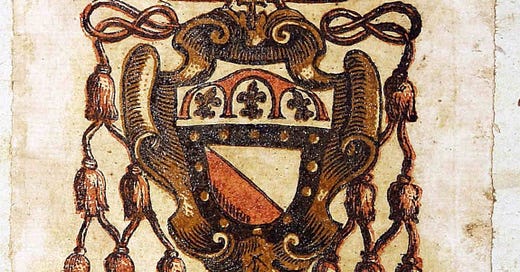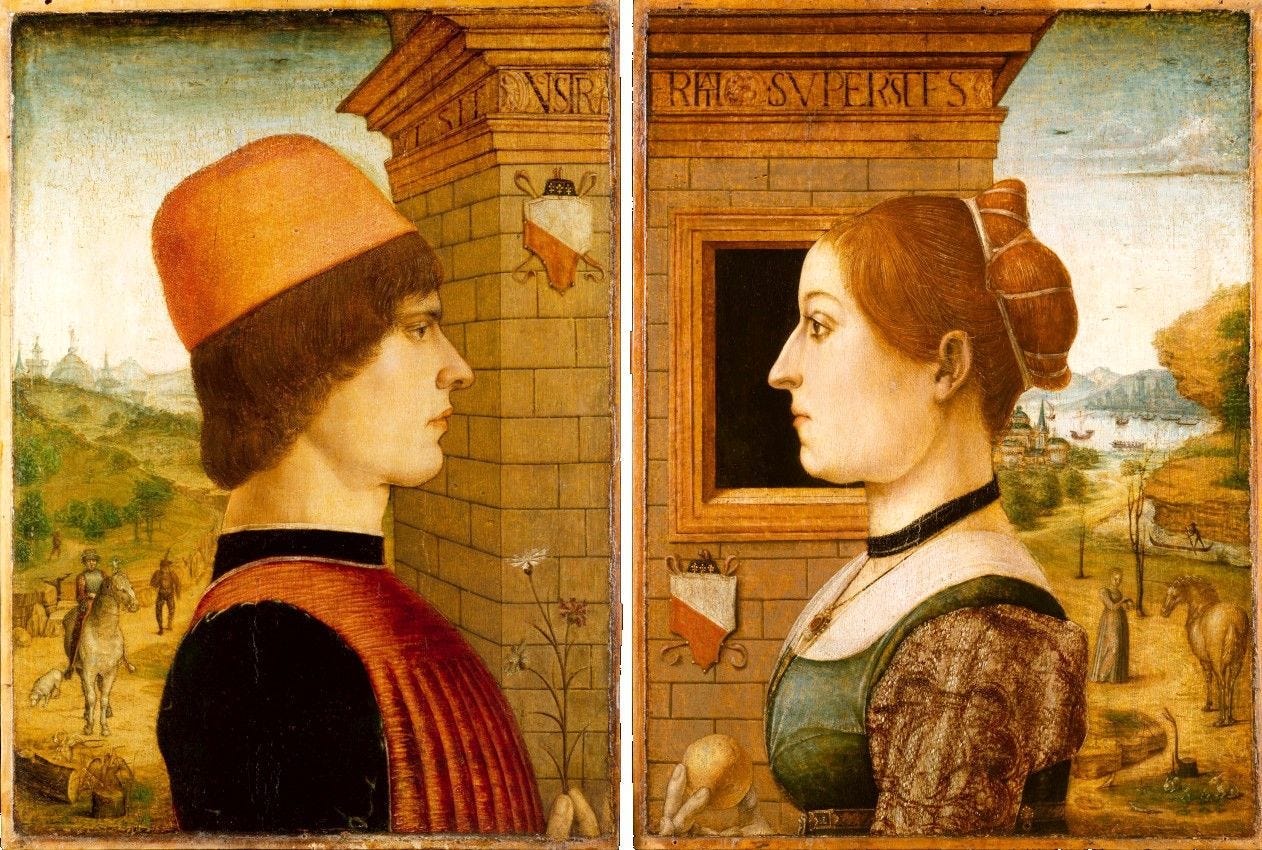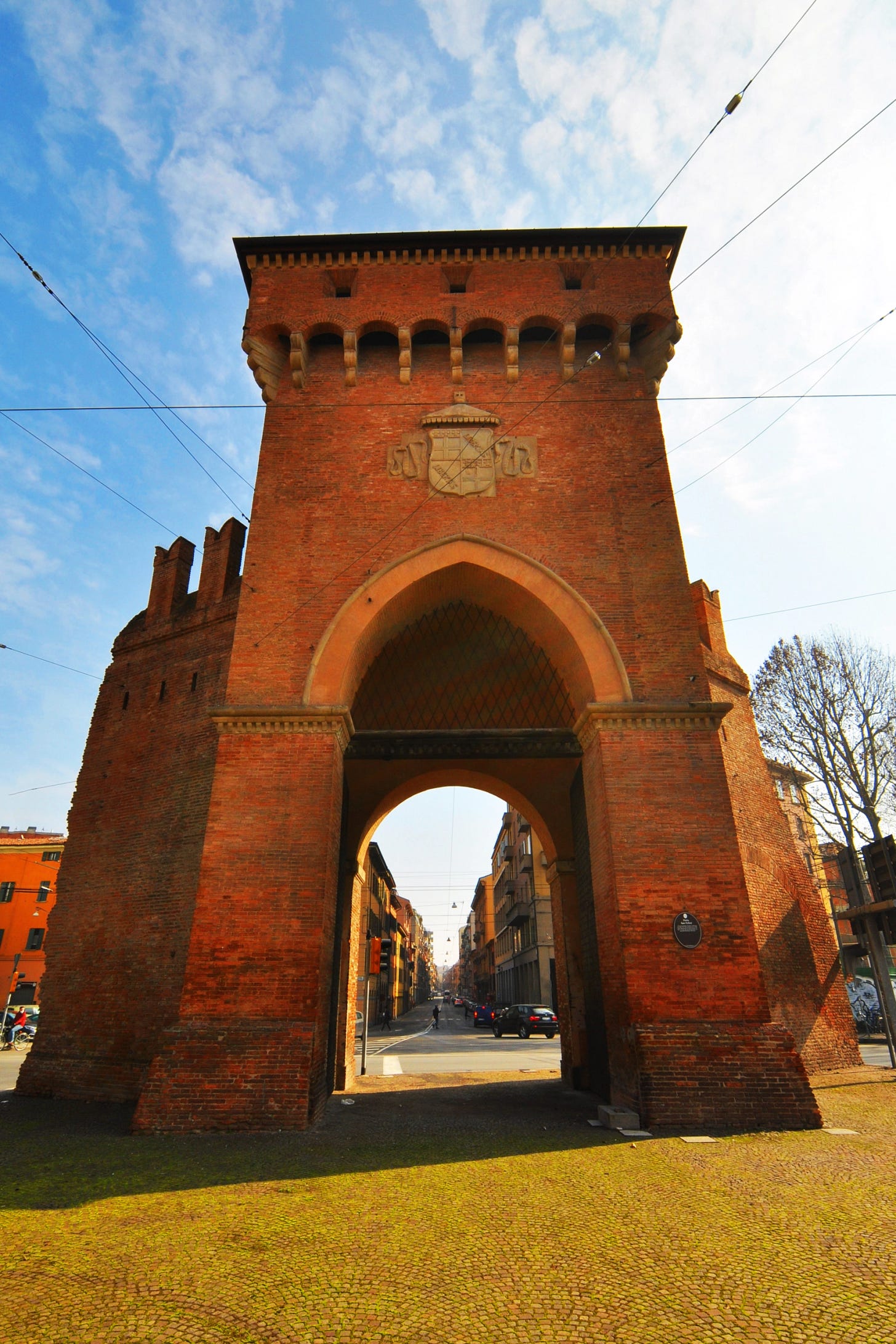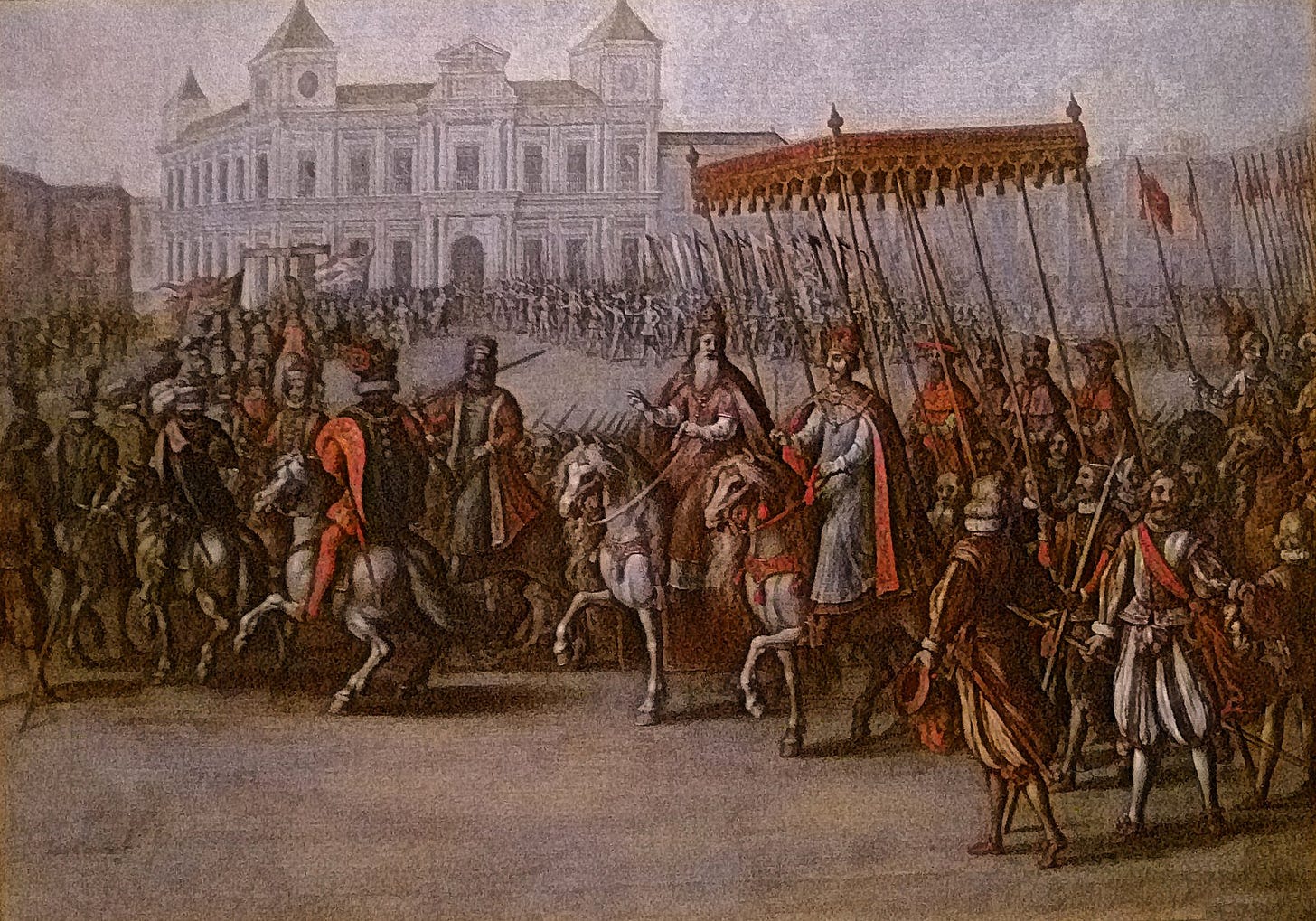"In Bologna We Make Daggers, and We Know How to Use Them."
Camillo Gozzadini vs the Empire in Bologna
Background: The Life of Camillo Gozzadini
Camillo Gozzadini was born on 5 February 1479, to Bernardino Gozzadini, scion of one of the oldest noble families in Bologna, known for their leading role in the Cambiatori, or the bankers guild. Bernardino was a courtier of the ruling Bentivoglio family, and a trusted friend of Giovanni II Bentivoglio, accompanying the Signoria on his trip to Loreto, and serving in his government as the Gonfaloniere di Giustizia in 1492 and 1497.
The Gozzadini family, who were distant relatives of the Bentivoglio, were in high esteem among the Bentivogleschi (the Bentivoglio faction) until 1501 when Bernardino was implicated in a plot to overthrow Giovanni Bentivoglio with the Marescotti family, after it was reported that he had met in secret with the exiled Pirro Malvezzi, who had also plotted to kill Giovanni in 1488, and as a result he was forced flee the city during the bloody purge that followed. He eventually returned to Bologna after a year away, but turmoil in 1506 around the planned usurpation of Giovanni Bentivoglio by Pope Julius II, led to his brutal murder at the hands of a mob incited by the Signoria, after a letter detailing the popes plans to conquer Bologna, from his son Giovanni who was a member of the papal curia, was intercepted by the Bentivogleschi. Bernardino tried to escape, dressed in a monk’s habit, but he was cornered by the mob at the San Stefano gate, which had been barred, and he was torn to pieces.
Camillo was not in Bologna at the time of his father’s murder, he was in Portugal serving as a courtier for King Emanuel I. While in Lisbon, Camillo distinguished himself on the battlefield and was knighted by the sovereign. He was making quite a name for himself in the vibrant Portuguese court when word of his fathers brutal murder reached him, and returned home in 1506. Upon his return, Camillo Gozzadini joined the retinue of Pope Julius II, and was a part of the triumphant entry on 11 November 1506. After Julius held mass in San Petronio, he awarded Gozzadini the title golden knight of San Petronio.
Gozzadini, and all the former Bentivogleschi exiles who returned to Bologna with the Pope proved to be colossal problem for the disgraced family. In 1507, after a failed assault on the city by the sons and grandsons of Giovanni Bentivoglio, Camillo took part in the destruction of the Bentivoglio Palazzo with Emilio Marescotti and 200 armed men. Not a single brick from the foundation of the building remained in place by the time they were finished.
Then in 1511 when Annibale Bentivoglio managed to return to power in Bologna thanks to the actions of the brilliant French captain Gaston de Foix, Gozzadini and the other former exiles were forced to flee Bologna once again. Camillo chose Rome, where his brother had continued his distinguished ecclesiastical career, and used his new apartment in the eternal city to write volumes of letters, attempting to undermine Annibale Bentivoglio.
In 1512, when the French were forced to withdraw from Italy, Camillo returned with his fellow exiles, and was present for the meeting in Bologna between Francis I, and pope Leo X, in 1515. Through the intercession of Pope Leo X, he was invested with the county of Zappolino.
Home at last, Camillo decided to try his hand at local politics, he became the mayor of Medicina and in 1517 became the deputy governor of Reggio as a proxy for his brother Giovanni, who was the legate. What may have seemed like an easy first gig turned out to be a nightmare when the city was ripped apart by factional infighting in June of that year between the Bebi and the Scaioli families. It got so bad, Camillo had no choice but to call his brother Giovanni back to the city from Rome. When his brother arrived, he was brutally murdered by a mob on the 28th of June, and Camillo had to fight through the bloodthirsty harangue to recover his body. He buried his brother in the church of San Maria della Misericordia, in Bologna.
Back in the city of towers, Camillo found himself feuding with his once-exiled allies the Marescotti. Ercole Marescotti, the father of Emilio, had become the Gonfaloniere di Giustizia in the wake of the French withdrawal in 1513, and unexpectedly made peace with the Bentivoglio in 1515. Ercole became a marked man when he started pushing pro-Bentivoglio policies in 1518, and was jumped by a group of armed men in June of that year while taking a ride through the Bolognese countryside, and died soon after. The perpetrator Virgilio Poeti tried to have the governor of the city, Lorenzo Fieschi, mediate a truce, but Emilio and his brother Gianluigi weren’t having it.
In 1518, during the course of the violent Marescotti vendetta, Camillo ended up in the crosshairs of Emilio Marescotti when suspicion arose that the Gozzadini cavalari might’ve been involved in the plot to off his old man, and the hotblooded student of the fencing maestro Achille Marozzo, challenged him to a duel. Camillo accepted the challenge, they were set to duel in Mantua, but the event never took place because Pope Leo X asked the Marquis of Mantua, Francesco II Gonzaga to mediate between the two parties. The Pontiffs still had a soft spot for the brother of his deceased legate Giovanni.
Still in the good graces of pope Leo after relenting to Gonzaga’s mediation, the Vicar sent Gozzadini to recover the city of Cento from Alphonso d’Este and his French allies. He was successful in the operation and was given the title, Papal Commissioner of Cento. However with Leo’s death a year later, the election of Adrian VI, and the subsequent shifts in alliances through northern Italy, Alphonso d’Este was able to recover the city a year later, despite Camillo’s best efforts to put up a resolute defense.
The conduct of his campaign in Cento bolstered the reputation of Gozzadini as a captain in Bologna. When word reached the city that Annibale Bentivoglio was building an army to attack the city in 1521, Camillo was given a seat on the on del Consiglio dei Dieci della Guerra, or the War Council of Ten. This was a precarious assignment for Gozzadini, because many of the nobles on the council, in the Anziani and Sedici (the prevailing structures of Bolognese government), and even the papal vice legate Bernardo dei Rossi, were still sympathetic to the Bentivoglio cause.
On Easter Sunday, 20 April 1522, the Bentivoglio attacked. Filippo Pepoli, Camillo Gozzadini, and Andrea Casali, mirrored the approach of Annibale Bentivoglio’s forces to the San Felice gate, where detachments under Annibale Rangoni, and Gentile da Sassatello, moved to scale the ramparts. Brutal fighting ensued as the 4000 man Bentivoglio force threw wave after wave at the ports defences, hoping to buy time so that a planned popular uprising could undermine the defenders. Camillo Gozzadini, for his part, accompanied his men atop the parapets and valorously led them in a spirited defence of the ramparts. Fortuitously, the Dieci della Guerra had anticipated Annibale’s strategy, and held the majority of the Bolognese forces in reserve under the Malzezzi, in order to prevent any gatherings of Bentivoglio sympathizers in the city. When Annibale realized that no uprising was going to facilitate his dream of becoming Signoria, that his plan had failed, he withdrew his men, and slinked back to Ferrara.
Camillo Gozzadini became a mainstay in Bolognese civic society, in 1524 and 1525 he was a senior consul in the Anziani, then in 1528 he was selected as a senator of the state by Pope Clement VII, and briefly served as the Gonfaloniere di Giustizia for a two month term between March and April of that year. As a senator Camillo was afforded the opportunity to take part in the coronation procession of the Holy Roman Emperor Charles V, in 1530. This is where our story begins.
Showdown in Bologna: The Account of Pompeo Vizani
Since riding in this way he reached the middle of the Via delle Chiavature, Cesare, taking permission from Pope Clement, turned towards the Church of San Domenico, in which he found himself, and here since he joined the College of Canons of San Giovanni Laterano, he made many knights of the Bolognese men by touching them lightly with the sword over the shoulder. And then finally he returned to the palace, where most of the Princes dined. Many Spanish soldiers; of whom, however, were born of the basest race; tired of the boring and proud walk, like truncated roosters, and with their heads revealed, who were still to be considered men of great size and high birth, they had taken on an insolent manner, due to the many greatnesses, which nevertheless were seen in the Princes , and in the illustrious people, who some of them imagined having Empire over the City of Bologna.
So they often proceeded in a way that was very displeasing to the citizens, showing that they despised everyone, and sometimes they also boasted that they had to treat the Bolognese badly, just as they had mistreated the Milanese, and therefore little by little they every hour the hatred between the Bolognese and Spaniards grew; for which reason, while walking one day in the square, some of them encountered Camillo Gozzadini Cavalario, in the company of Marc'Antonio Lupari, both highly honored Senators, and wanting to pass through them they said very impertinent words, to which they boldly, and as to gentlemen it was agreed upon, were answered by the two Senators; so, feeling outraged, the Spaniards called a large crowd of soldiers into their company, and with much advantage they attacked Gozzadini & Lupari, who in the company of some of their friends and servants, upon coming to the disadvantage, and finding Lupari wounded in the thigh, they retreated deftly to the house of the Lambertini, which was near the square in the Via de gli Orefici, where they had seized certain weapons from the home, and returned to find the Spaniards, to whom they gave many wounds; but with a large number of people contributing, they were divided; & Marc Antonio was taken to the house seriously wounded, where he stayed several days before he recovered.
In the meantime Gozzadini, unable to tolerate the fact that the Spaniards had dared to insult him, decided to take revenge; & having conferred his thoughts with Gieronimo Pepoli, and with certain other leading gentlemen; each of them rallied many young Bolognese, in whose company they went around the city at night and killed as many Spaniards and Germans as they encountered in the dark: for which reason, since the Spaniards had already lacked some pride, they now had almost no more courage to go around at night; whereupon Antonio da Leiva, their General Captain, was disdained and complained to the Pontiff, praying to his Holiness to forbid the Bolognese from bearing arms, but while he was having this negotiation, it happened that Camillo Gozzadini was present, who responding to the words of Antonio da Leiva, said, “we carry our arms for reasons of chivalrous nobility, & to dissuade those who recklessly try to insult us, & thus for our defense, & by the service of the Supreme Pontiff we will bear them with the good grace of his Holiness.” Then the Spanish General, having little regard even for the Pontiff, replied; “we have put the shackles on in Milan, and perhaps we will put the shackles on again in Bologna; but Gozadini, upon hearing the General of the City, secured under the protection of the Holy Church, added boldly, “In Milan they make needles, and in Bologna they make daggers, and there are people who know how to put them to work.”
Conclusion
Neither the Pope or the Emperor, wanted to touch this affair. Bologna had been under Imperial occupation for a considerable amount of time, and they both decided it was best to leave Gozzadini be. Camillo, the knight, doctor of law, father and Bolognese statesman, passed away on 16 December 1532 of natural causes. He was buried in the church of San Maria della Misericordia beside his beloved brother Giovanni.
Transcription of Vizani
Poiche cosi cavalcando si giunse al mezo della via detta delle Chiavature, Cesare pigliando licenza da Papa Clemente, piego verso la Chiesa di San Domenico, nella qual'eutro, e quiui poiche su aggreato nel Collegio de Canonici di San Giovanni Laterano, fece cavalieri assai getil'huomani Bolognesi toccandogli leggieremente con la spada sopra la spalla. Et poi finalmente torno a palazzo, dove cenarono la maggior parte de Prencipi. Molti soldati Spagnuoli; di quei pero, quali erano nati di piu vile razza; cercando col noioso, & superbo passeggiare, come galli tronsi, & con la testa rivelata, di esser tenuti efsi ancora huomini di gran pezza, & di alto legnaggio, erano divenuti di maniera insolenti, per le tante grandezze, che tuttavia si vedevano ne Prencipi, & nelle persone illustri, che alcuni di loro s'imaginava di haver Imperio sopra la Citta di Bologna; onde procedevano spesse volte in modo assai dispia cevo'e co' cittadini, mostrando di sprezare ogn'uno, & alcune volte ancora si vantavano di haver a trattar male i Bolognesi, come havevano malttattari i Milanesi, & percio a poco a poco d'ogni hora cresceva l'odio fra Bolognesi, & Spagnuoli; per la qual cosa passeggiando un giorno in piazza alcuni di coloro scontrarono Camillo Gozzadini Cavalario, in compagnia di Marc'Antonio Lupari amendue Senatori assai honorati, & volendo passar per mezo loro dissero parole molto impertinenti, alle quali arditamente, & come a gentil'huomini si conveniva su risposto da i due Senatori; ondetenendosi oltraggiati gli Spagnnuoli chiamatono in compagnia lore una gran frotta di soldati, e con molto vantaggio assalirono il Gozzadini e il Lupari, quali in compagnia di certi loro amici, & servitori, venendo il disvantaggio, & trovandosi fecito il Lupari in una coscia, si andarono destramente ritirando fino alla casa de Lambertini, la qual'era presso alla piazza nella via de gli Orefici, done havendo dato di piglio a certe armi d'hasta, tornarono a trovar gli Spagnuoli, a quali die dero di molte ferite; ma concorrendovi gran numero di gente fuorono spartiti; e Marc Antonio su portato serito a casa, dove stette parecchi giorni prima che si risanasse. In tanto il Gozzadini no potendo tolerate, che gli Spagnoli havessero havuto ardire di oltraggiarlo delibero di vendicarsi; & havendo conferito il suo pensiero con Gieronimo Pepoli, & con certi altri gentil'huomini principali; ciascuno di loro mise infieme assai giovani Bolognesi, in compagnia de' quali andando la notte ttorno per la Citta, uccidevano quanti Spagnuoli, e Tedeschi scontranano al buio: per la qual cosa essendo gia mancato alquanto l'orgoglio a gli Spagnuoli, essinon havevano quasi piu ardire di andare attorno di notte; la onde sdegnato Antonio da Leiva lor General Capitano, fece dicio querela col Pontefice, pregando sua Santita, che vietasse a Bolognese il portar arme, ma mentre ch' egli parlava di tal negotio, avenne che vi si trovo presente Camillo Gozzadini , quale rispondendo alle parole d'Antonio da Leiva, disse; noi portiamo le nostr'arme per ragione di cavaleresca nobilita, & per disensarcida chi temerariamente cerca di farci oltraggio, & cosi per nostra difesa, & per seruigio del sommo Pontefice lel porteremo con buona gratia di sua Santita. All'hora il General Spagnuolo havendo poco riguardo anco al Pontifice, rispose; noi havviamo posto il freno a Milano, & forse se ancora lo porremo a Bologna; ma ill Gozadini undendo parlare di tal maniera il Generale di una Citta assicurata sotto la protettione di santa Chiesa, soggiunse arditamente. A Milano si fanno agucchie, & a Bologna si fanno pungali, & vi sono persone che sanno mettergli in opera
Works Cited:
Vizzani, Pompeo. Historie di Bologna. Italy, Rossi, 1602. Pg. Link
Magoni, Clizia. Dizionario Biografico degli Italiani - Volume 58 (2002), Camillo Gozzadini. Treccani.it. https://www.treccani.it/enciclopedia/camillo-gozzadini_(Dizionario-Biografico)/. Accessed 11/25/2023.
Ciuccarelli, Cecilia. Dizionario Biografico degli Italiani - Volume 58 (2002), Bernardino Gozzadini. Treccani.it. https://www.treccani.it/enciclopedia/bernardino-gozzadini_(Dizionario-Biografico)/?search=GOZZADINI%2C%20Bernardino. Accessed 11/25/2023.
De Caro, Gaspare. Dizionario Biografico degli Italiani - Volume 8 (1966), Annibale Bentivoglio. Treccani.it. https://www.treccani.it/enciclopedia/annibale-bentivoglio_(Dizionario-Biografico)/. Accessed 11/25/2023.
Brizzi, Gian Paolo. Dizionario Biografico degli Italiani - Volume 21 (1978), Andrea Casali. Treccani.it. https://www.treccani.it/enciclopedia/andrea-casali_res-26d62ed3-87ea-11dc-8e9d-0016357eee51_(Dizionario-Biografico)/. Accessed 11/26/2023.
Damiani, Roberto. Annibale Bentivoglio. Condottieriventura.it. https://condottieridiventura.it/annibale-bentivoglio/. Accessed 11/26/2023.








